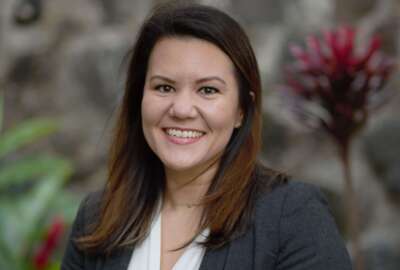
The Defense Innovation Unit says its positively sailing into its 8th year in business
The small but potent Defense Innovation Unit (DIU) has reached its stride, as it enters its eighth year in business. The DIU uses a technique known as "other...
The small but potent Defense Innovation Unit (DIU) has reached its stride, as it enters its eighth year in business. The DIU uses a technique known as “other transaction authority” to quickly get new technology prototypes built for military purposes. Last year, those awards reached a billion dollars. For some highlights from its latest annual report, the Federal Drive with Tom Temin spoke with DIU’s Acting Director Mike Madsen.
Interview transcript:
Tom Temin
Before we get to the numbers and the acquisitions transactions, give us a sense of some of the exciting technologies that were actually realized into prototype or into production in the past year, via DIU.Mike Madsen
So we transitioned 17 projects this year, which is a record for us. And some of the exciting ones are things like, what we call, Peacetime Indications and Warning, which is leveraging commercial technologies, what we do largely, but in this case, that technology is commercially available overhead satellite imagery. There’s a growing market for that in the commercial sector. Real estate developers are interested in persistent overhead imagery, to look at parking lots with cars, to make sure the real estate is being used most effectively, or futures traders, want to say your level of resources in tanks around the world for their positioning. But we use for, real-time situational awareness around the world, where we have persistent capability to do that. Another very exciting one that we transition this year, is called the Rapid Assessment of the Threat Environment. And this is incredibly powerful, because a project that was wrapping up at the end of 2019. And this was a project using wearables and AI to be able to take infectious diseases. So think, pre COVID. So 2019, that was things like the flu, where it would be important for a commander to know infection rates before it spread through a large organization. So you can isolate those folks. While we were able to pivot very, very quickly, in 2020, and apply this to COVID. And we got to the point where we were able to identify folks that were COVID positive, 48 hours before testing and 48 hours before symptom onset. So if you think of the power of that, from a readiness perspective, we’re able to isolate those folks and limit the infection flowing through large organizations.Tom Temin
That one’s really a big contribution to readiness, I would say.Mike Madsen
Absolutely, you’re able to isolate folks and limit the spreading of infectious diseases through a squadron, a division, etc. To make sure you maintain the highest levels of readiness.Tom Temin
But no magic death ray that can take out an entire enemy platoon yet.Mike Madsen
Right. No, no, nothing like that. That’s still under wraps.Tom Temin
All right. And I wanted to talk about the OTAs, that billion dollar figure, is that cumulative in the life of DIU? Or is that just the last year?Mike Madsen
I know that’s cumulative, backing down for a little bit of context, you’re exactly right. DIU uses other transaction authority, which is a fully congressionally authorized way to procure goods and services for the department. And what we do is, we leverage our [Department of Defense (DoD)] partners funding, so they have skin in the game when we do their prototypes, so that we know there’s a clear path to production on the backside. So we can get that technology into the hands of the men and women in uniform. But also, for our commercial partners, it’s a path to recurring revenue, which is important to them, and increase that connective tissue between government and private sector. So that 1.2 billion is exactly right, is cumulative over the life of DIU, since we started in 2016.Tom Temin
And I think, maybe, the lesser known part of DIU, is that you also can do production contracts, to move those innovations that were, maybe, acquired initially under the OTA, to production level. And talk about some of the highlights, of the past year,that moved from prototype to production.Mike Madsen
Well, that’s the power of the other transaction authority, Tom, that you mentioned before. Is our authority to operate allows us to move from prototype to production, without recompeting, provided that the prototype was awarded under competitive circumstances. And we developed a competitive commercial solutions opening process that meets that competitive requirement. Now, our commercial solutions opening or CSO, it increases transparency and increases competition for our DoD partners, we can continue to drive the cost down and be as effective and efficient as possible. But what it also does is, it lowers barriers to entry to the defense marketplace for some of those nontraditional companies. We simplify the process. We make it easy and we make it cheaper. We recognize the opportunity cost just to participate in the defense marketplace for some of these nontraditional. So all of that is designed to increase the participation rate.Tom Temin
We’re speaking with Mike Madson. He is acting director of the Defense Innovation Unit. And I wanted to ask about, just to take an aside here for a moment. There was a lot of commercial support to Ukraine that you are reporting in the past year, as part of the annual report. Pretty high up in there. Just give us a highlight there.Mike Madsen
Well, Ukraine is a fantastic opportunity to watch us, how do we use technology is integrated into warfighting. And I think it’s pretty clear that it’s not going to be the first one that develops this technology, but the way that we integrate it, is going to lead to success on the battlefield. So we’ve been able to observe a couple things. A few lessons we’ve learned, is number one, democratization of this technology. The dual use commercial technology, it’s out there, it’s widely available, we don’t get a vote in how our adversaries are going to use it. So we need to make sure we’re evaluating it real-time and pulling it in. And making that minor customization, proving through prototyping, before adversaries can. We also need to identify those technologies that we want to protect and much more closely. But another lesson learned is, and I used overhead imagery, I’ll use that example again. The classification level. So that overhead imagery, that’s widely available now, is not classified. So it can be put out to the world. And as we saw in Ukraine, that commercially available overhead imagery was available to be broadcast to the world to counter Russian narratives, by photographic evidence showing what’s really happening on the ground, instead of something that they were trying to construct or engineer.Tom Temin
Yeah, so the companies that provided through you to Ukraine, this remote sensing and observability, let’s say platforms, that really, I guess, leveraged the power that they could get out of the weapons systems that we shipped to them. They can aim at where the bad people were.Mike Madsen
Right, exactly that integration, that dual use technology. Now for us, we have not provided anything directly to Ukraine, we work with our global combatant commanders or regional combatant commander. So we work with [European Command (EUCOM)], pretty closely with EUCOM. But what’s interesting first watch, is that vendors are selling directly to the Ukrainian government, with some of those capabilities.Tom Temin
Right. And that’s one of the complications that a lot of independent DoD agencies face. Not a challenge, but maybe it’s challenging, is that so much happens through the combatant commands, which are Joint. And somehow, you have to work in what you’re doing with what the combatant commands need. And it gets to be a little bit of a, complicated shopping mall, if you will.Mike Madsen
Right. And in fact, our transition rate is about 50%. A couple of years ago, we took a look at our transition rate and what we needed to do to increase it. It was about 35%. And one of the things we found, and one of the outcomes was, we developed a defense engagement team that is focused on engaging with our DoD partners. We focus on the services agencies. But also, we engage with the combatant commands. Because that’s where the requirements are generated. That’s where the rubber meets the road. The warfighting needs are really identified there and then passed back to the services, for the organized training equipped function. So we engage everywhere we can to make sure that we are in a position to articulate the state of the art of the commercial technology, and how it might help solve some DoD problems.Tom Temin
And do the requirements, for what you might want to issue an OTA and discover some innovation. Do they come from the combatant commands? Or do they come from the individual forces?Mike Madsen
Well, we found a successful project has three elements. We need an end user that understands the problem is going to use it, we need programmatic support, and we need command support. And so what we do is then, we take that we work with that vertical, and we get away from a long arduous requirements document, and go to a simply stated problem statement. Now, the problem that we put out to our commercial partners to come up with innovative solutions, is rooted in the requirements of the service. But we simplify it, we take out the Pentagon jargon, we take out the acronyms, and we put it in a language that our commercial partners understand and can respond to.Tom Temin
And do you ever get into like, very small, issues requirements that may be an individual soldier, or some units or pilot identified? If we enlarge, I’m thinking of like in World War II, some countries needed bigger trigger guards on pistol so you can get your hands through there with a glove on, that kind of thing. Does it ever get that fine grained.Mike Madsen
We do look for any problems that the end users are having. But as we go through a very deliberate process that’s called our project decision board. It’s the process by which we take on projects. And we’re at the point now, where we can take on some of those one-off projects. But largely, we look for those challenges that can scale across the department, across platforms, across services. A couple examples I’ll give, we completed a project using AI, it’s predictive maintenance as the name of the project that we took on. It started with the Air Force. And again, if you think about it, it’s using AI to predict maintenance failures on parts of very complex machines with many moving pieces and parts. And we started with the Air Force, we took it to production with the Air Force. And then we looked at the Army and the Navy and we said, I bet there are probably some challenges here we could solve. So then we engage with the Army and the Navy to scale that across those platforms, not only the ones that can fly in the Army, but also those wheeled vehicles as well. Those are the projects we look for those the homeruns, as we call them. But that’s not to say we won’t take on some of the one-off projects as well.Tom Temin
Right. Something small could have enterprise-wide application, like a better shoe lace or something.Mike Madsen
and that outsize impact, exactly right.Tom Temin
And if you would just discuss the issue of, we’ve talked about dual use technologies from, small and large companies. And this is in the context of the shrinking small business sector of the defense industrial base. I guess the large businesses are shrinking to, in terms of numbers of companies. Is it a strategy of DIU to help increase that? Or is that a byproduct of what you do? Or do you think about that?Mike Madsen
Well, what we look for is the nontraditional companies. And in fact, our authority to operate, specifically, calls out nontraditional companies. But there’s also provisions for us to partner with the traditional companies systems integrators. The modernization in the department is going to take all players, at all strata. But what we are very excited about, is that we have been able to bring in a large number of nontraditional companies, as well as first time vendors. So these are vendors that have evaluated the, what is now, $820 billion defense marketplace. Previously said, no thanks. We have a robust commercial consumer base. So we don’t necessarily need to bring our technology to you. We’ve been able to change their minds, show them that it’s not complex, there is a path that we can illuminate to the defense marketplace. They’ve been able to bring that technology, and get it in the hands of the men and women in uniform.Tom Temin
Sounds like there’s an orientation toward trying to find small, but nontraditional doesn’t have to be small, I mean, maybe, something at Procter and Gamble, which is not what you think I’m just made that up, as a defense supplier, but it’s nontraditional, in the sense that it’s not Lockheed or General Dynamics.Mike Madsen
Exactly right. We don’t focus on the the size of the company, but rather the the nontraditional and the technology. In fact, I think, three quarters of the companies that we have awarded contracts to have been small business. Not necessarily by design, but just, sometimes, that’s where the nontraditional and the agility lies. Now, we’ve been able to successfully partner, like I said, with some of the traditional companies for that scale up capability, that I mentioned, were scaling adoption. That’s really what we’re looking at to get that technology into DoD.Tom Temin
And what’s going to happen in fiscal 2023. We’re well into it, but how are things going?Mike Madsen
Oh, it’s great. It’s such a fantastic time. We got in ’23, we got an increase in our budget. So that was very exciting. That tells me we’re showing value to our important stakeholders. We’ve also increased the number of projects, and we’ve seen an increase in the number of submissions. So that tells me we’ve shown value to both our defense partners, as well as our commercial partners. But if you think of where we started, where we’re going, in our early days, we were just trying to prove out the concept. We’ve been able to prove that out. So then we moved the goalposts and said, All right, let’s focus on transition. And we’ve been able to get to 50%. I’ve challenged the team to continue to drive that hire. But then we started looking at, well, what’s our adoption rate of those transitions? So let’s move the goalposts, again, and look to make sure we’re scaling as widely as possible. So as we look out to ’23, we’re going to keep doing our core mission, which is getting that technology into DoD. But we’re going to do it by focusing a little bit earlier with the program officers, so that we’re able to very clearly describe to them the state of the art of the commercial technology and where it might fit into some of the solutions that they’re looking at.Tom Temin
So the valleys of death will have bridges?Mike Madsen
I love that you used valleys of death, too often we hear one single, all encompassing valley, but we’ve been able to identify multiple valleys at multiple stages of development. DIU is made up of three suborganizations that targets some of those valleys and various development points in the company. So thank you for using the plural with that, Tom. I appreciate it.
Copyright © 2025 Federal News Network. All rights reserved. This website is not intended for users located within the European Economic Area.
Tom Temin is host of the Federal Drive and has been providing insight on federal technology and management issues for more than 30 years.
Follow @tteminWFED
Related Stories





